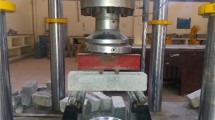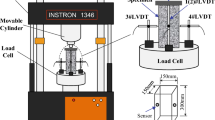Abstract
This research aims at studying the relationship between the electrical resistivity and the damage of the SFRC during uniaxial compression. The electrical resistivity of concrete with four different volume fraction of steel fibers (0.0%, 1.0%, 1.5% and 2.0%) during uniaxial compression was tested. The effect of the number of steel fibers on the electrical resistivity of concrete was analyzed. Results showed that the addition of steel fibers reduces the initial electrical resistivity of concrete. When the volume fraction of steel fibers reached 1.5%, the conductive capacity of the concrete tended to reach its maximum, then the electrical resistivity decreased slowly and stabilized. During uniaxial compression, the electrical resistivity changing curves can be simplified as two modes, hook-shaped for plain concrete and "U"-shaped for SFRC. The relationship of the load and the electrical resistivity during uniaxial compression indicated that the electrical resistivity is determined by the combined effects of the micro-crack structure and the steel fibers. The change of the electrical resistivity of SFRC can reflect the evolution of concrete internal structure during loading.









Similar content being viewed by others
References
Ran JL, Li TC, Chen DH, Shang LM (2021) Mechanical properties of concrete reinforced with corrugated steel fiber under uniaxial compression and tension. Structures 34:1890–1902. https://doi.org/10.1016/j.istruc.2021.08.135
Raju RA, Lim S, Akiyama M, Kageyama T (2020) Effects of concrete flow on the distribution and orientation of fibers and flexural behavior of steel fiber-reinforced self-compacting concrete beams. Constr Build Mater 262:119963. https://doi.org/10.1016/j.conbuildmat.2020.119963
Nancy K, Hilal EH, Tamer EM (2020) Influence of steel fibers on the flexural performance of concrete incorporating recycled concrete aggregates and dune sand. J Sustain Cem-Based 10(3):165–192. https://doi.org/10.1080/21650373.2020.1809546
Golpasand G, Farzam M, Shishvan SS (2020) FEM investigation of SFRCs using a substepping integration of constitutive equations. Comput Concr 25(2):181–192. https://doi.org/10.12989/cac.2020.25.2.181
Aiello MA, Leuzzi F, Centonze G, Maffezzoli A (2009) Use of steel fibers recovered from waste tyres as reinforcement in concrete: pull-out behaviour, compressive and flexural strength. Waste Manage 29(6):1960–1970. https://doi.org/10.1016/j.wasman.2008.12.002
Martinelli E, Caggiano A, Xargay H (2015) An experimental study on the post-cracking behavior of hybrid industrial/recycled steel fiber-reinforced concrete. Constr Build Mater 94(30):290–298. https://doi.org/10.1016/j.conbuildmat.2015.07.007
Zamanzadeh Z, Lourenco L, Barros J (2015) Recycled steel fiber reinforced concrete failing in bending and in shear. Constr Build Mater 85:195–207. https://doi.org/10.1016/j.conbuildmat.2015.03.070
Ammouche A, Riss J, Breysse D, Marchand J (2001) Image analysis for the automated study of microcracks in concrete. Cem Concr Compos 23(2):267–278. https://doi.org/10.1016/S0958-9465(00)00054-8
Onuaguluchi O, Banthia N (2018) Scrap tire steel fiber as a substitute for commercial steel fiber in cement mortar: engineering properties and cost-benefit analyses. Resour Conserv Recycl 134:248–256. https://doi.org/10.1016/j.resconrec.2018.03.014
Mastali M, Naghibdehi MG, Naghipour M, Rabice SM (2015) Experimental assessment of functionally graded reinforced concrete (FGRC) slabs under drop weight and projectile impacts. Constr Build Mater 95:296–311. https://doi.org/10.1016/j.conbuildmat.2015.07.153
Mohammadi Y, Singh SP, Kaushik SK (2008) Properties of steel fibrous concrete containing mixed fibres in fresh and hardened state. Constr Build Mater 22:956–965. https://doi.org/10.1016/j.conbuildmat.2006.12.004
Sanjay MR, Madhu P, Jawaid M, Senthamaraikannand P, Senthild S, Pradeepb S (2018) Characterization and properties of natural fiber polymer composites: a comprehensive review. J Clean Prod 172:566–581. https://doi.org/10.1016/j.jclepro.2017.10.101
Nili M, Afroughsabet V (2010) Combined effect of silica fume and steel fibers on the impact resistance and mechanical properties of concrete. Int J Impact Eng 37:879–886. https://doi.org/10.1016/j.ijimpeng.2010.03.004
Javahershenasa F, Gilania SM, Hajforoushb M (2021) Effect of magnetic field exposure time on mechanical and microstructure properties of steel fiber-reinforced concrete (SFRC). J Build Phys 35:101975. https://doi.org/10.1016/j.jobe.2020.101975
Havlikova I, Merta I, Schneemayer A, Veselý V, Šimonová H (2015) Effect of fiber type in concrete on crack initiation. Appl Mech Mater 769:308–311. https://doi.org/10.4028/www.scientific.net/AMM.769.308
Pajak M, Ponikiewski T (2013) Flexural behavior of self-compacting concrete reinforced with different types of steel fibers. Constr Build Mater 47:397–408. https://doi.org/10.1016/j.conbuildmat.2013.05.072
Bernat ARM, Spinella N, Recupero A, Cladera A (2020) Mechanical model for the shear strength of steel fiber reinforced concrete (SFRC) beams without stirrups. Mater Struct 53:1399–1419. https://doi.org/10.1617/s11527-020-01461-4
Spinella N (2013) Shear strength of full-scale steel fiber-reinforced concrete beams without stirrups. Comput. Concr 5:365–382. https://doi.org/10.12989/cac.2013.11.5.365
Dorota BK (2013) Life cycle assessment of steel production in Poland: a case study. J Clean Prod 54:235–243. https://doi.org/10.1016/j.jclepro.2013.04.031
FolinoP RM, Xargay H, Rocca N (2020) Comprehensive analysis of fiber reinforced concrete beams with conventional reinforcement. Eng Struct 202:109862. https://doi.org/10.1016/j.engstruct.2019.109862
Matthias M, Louise AP, Tim F (2017) Measurements of mode I interlaminar properties of carbon fiber reinforced polymers using digital image correlation. Key Eng Mater 4549:652–659. https://doi.org/10.4028/www.scientific.net/KEM.742.652
Taheri S (2019) A review on five key sensors for monitoring of concrete structures. Constr Build Mater 204:492–509. https://doi.org/10.1016/j.conbuildmat.2019.01.172
Li CY, Zhao ML, Zhang XY, Li J (2021) Effect of steel fiber volume fraction on shear behavior of reinforced expanded-shale lightweight concrete beams with stirrups. Materials 14(5):1107. https://doi.org/10.1016/j.conbuildmat.2021.14051107
Gao DY, Ding C, Pang YY, Yang L (2021) Diverse angle-length-width model for 3D/4D/5D steel fiber reinforced concrete under tension. Constr Build Mater 266:121149. https://doi.org/10.1016/j.conbuildmat.2021.121149
Zeng XH, Liu HC, Zhu HS, Ling CB (2020) Study on damage of concrete under uniaxial compression based on electrical resistivity method. Constr Build Mater 254:119270. https://doi.org/10.1016/j.conbuildmat.2020.119270
Tabbagh J, Samouëlian A, Tabbagh A, Cousin I (2007) Numerical modelling of direct current electrical resistivity for the characterisation of cracks in soils. J Appl Geophys 62:313–323. https://doi.org/10.1016/j.jappgeo.2007.01.004
Polder R, Andrade C, Elsener B (2001) Test methods for on site measurement of resistivity of concrete-a RILEM TC-154 technical recommendation. Mater Struct 15:125–131. https://doi.org/10.1016/S0950-0618(00)00061-1
Balestra CET, Nakano AY, Savaris G, Medeiros-Junior RA (2019) Reinforcement corrosion risk of marine concrete structures evaluated through electrical resistivity: proposal of parameters based on field structures. Ocean Eng 187:106167. https://doi.org/10.1016/j.oceaneng.2019.106167
Lencioni JW, Medeiros-Junior RA (2021) Analysis of different parameters in the electrical resistivity test of concrete. Int J Civ Eng 19:27–38. https://doi.org/10.1007/s40999-020-00559-8
Robles KPV, Kim DW, Yee JJ, Lee JW, Kee SH (2020) Electrical resistivity measurements of reinforced concrete slabs with delamination defects. Sensors 20(24): 7113. https://www.mdpi.com/1424-8220/20/24/7113
Zhou CS, Li KF, Han JG (2012) Characterizing the effect of compressive damage on transport properties of cracked concretes. Mater Struct 45:381–392. https://doi.org/10.1617/s11527-011-9771-4
Sang Y, Yang YZ (2020) Assessing the freezing process of early age concrete by resistivity method. Constr Build Mater 238:117689. https://doi.org/10.1016/j.conbuildmat.2019.117689
Li L, Dao V, Lura P (2021) Autogenous deformation and coefficient of thermal expansion of early-age concrete: Initial outcomes of a study using a newly-developed Temperature Stress Testing Machine. Cement Concrete Comp 119:103997. https://doi.org/10.1016/j.cemconcomp.2021.103997
Zheng ZS, Wei XH (2021) Mesoscopic models and numerical simulations of the temperature field and hydration degree in early-age concrete. Constr Build Mater 266:121001. https://doi.org/10.1016/j.conbuildmat.2020.121001
Solgaard AOS, Geiker M, Edvardsen C, Küter A (2013) Observations on the electrical resistivity of steel fiber reinforced concrete. Mater Struct 47:335–350
Wang H, Ji HG, Cheng H (2011) Experimental study on electrical conductivity of steel fibers concrete under uniaxial compression. Appl Mech Mater 94–96:918–922. https://doi.org/10.4028/www.scientific.net/AMM.94-96.918
GB 1596–91, Fly ash used for cement and concrete. State Bureau of Technical Supervision, 1596 (in Chinese).
Shi XJ, Park P, Rew Y, Huang K (2020) Constitutive behaviors of steel fiber reinforced concrete under uniaxial compression and tension concrete. Constr Build Mater 233:117316. https://doi.org/10.1016/j.conbuildmat.2019.117316
Zhang YX (2019) Influence of fiber type and dosage on the mechanical properties and permeability of concrete. Harbin Engineering University. (In Chinese)
Liew KM, Arslan A (2020) The recent progress of recycled steel fiber reinforced concrete. Constr Build Mater 232:117232. https://doi.org/10.1016/j.conbuildmat.2019.117232
Setti F, Ezziane K, Setti B (2020) Investigation of mechanical characteristics and specimen size effect of steel fibers reinforced concrete. Constr Build Mater 34:1709340. https://doi.org/10.1080/01694243.2019.1709340
Li LG, Zhuo HX, Zhu J, Kwan AKH (2019) Packing density of mortar containing polypropylene, carbon or basalt fibers under dry and wet conditions. Powder Technol 342:433–440. https://doi.org/10.1016/j.powtec.2018.10.005
Yoo DY, Kang ST, Lee JH, Yoon YS (2013) Effect of shrinkage reducing admixture on tensile and flexural behaviors of UHPFRC considering fiber distribution characteristics. Cem Concr Res 54:180–190. https://doi.org/10.1016/j.cemconres.2013.09.006
Chu SH, Jiang Y, Kwan AKH (2019) Effect of rigid fibers on aggregate packing. Constr Build Mater 224:326–335. https://doi.org/10.1016/j.conbuildmat.2019.07.072
Ramezanianpour AA, Esmaeili M, Ghahari SA, Nagafi MH (2013) Laboratory study on the effect of polypropylene fiber on durability, and physical and mechanical characteristic of concrete for application in sleepers. Constr Build Mater 44:411–418. https://doi.org/10.1016/j.conbuildmat.2013.02.076
Duan Z, Yan XS, Sun Q, Tan X, Chen X (2022) New models for calculating electrical resistivity of loess loses affected by moisture content and NaCl concentration. Environ Sci Pollut R 29:17280–17294
Lowke D, Gehlen C (2017) The zeta potential of cement and additions in cementitious suspensions with high solid fraction. Cem Concr Res 95:195–204. https://doi.org/10.1016/j.cemconres.2017.02.016
Polder RB (2001) Test methods for on site measurement of resistivity of concrete a RILEM TC-154 technical recommendation. Constr Build Mater 15(2–3):125–131. https://doi.org/10.1016/S0950-0618(00)00061-1
Helmholtz, (1853) XLVIII. On the methods of measuring very small portions of time, and their application to physiological purposes. Phil Mag Lett 4:313–325. https://doi.org/10.1080/14786445308647375
Revil A (1996) Theory of ionic-surface electrical conduction in porous media. Phys Rev B 55:1757–1773. https://doi.org/10.1103/PhysRevB.55.1757
Liu HQ, Jie T, Li B, Youming D, Chunning Q (2017) Study of the low frequency dispersion of permittivity and resistivity in tight rocks. J Appl Geophys 143:141–148. https://doi.org/10.1016/j.jappgeo.2017.05.018
Zhang D, Cao Z, Fan L, Liu SY (2014) Evaluation of the influence of salt concentration on cement stabilized clay by electrical resistivity measurement method. Eng Geol 170:80–88. https://doi.org/10.1016/j.enggeo.2013.12.010
Wei XH, Xiao LZ, Li ZJ (2006) Conductive mechanism and hydration property of cement-based materials with steel fibers. Concrete 198:11–14 ((in Chinese))
Han BG, Ding SQ, Yu X (2015) Intrinsic self-sensing concrete and structures: A review. Measurement 59:110–128. https://doi.org/10.1016/j.measurement.2014.09.048
Yang YX (2002) Methods study on dispersion of fibers in CFRC. Cement Concrete Res 32(5):747–750. https://doi.org/10.1016/S0008-8846(01)00759-1
Demirel B, Yazicioğlu S, Orhan N (2006) Electrical behaviour of carbon fibre-reinforced concrete with increasing loading in varying and constant frequencies. Mag Concrete Res 58(10):691–697. https://doi.org/10.1680/macr.2006.58.10.691
Acknowledgements
This research is supported by The Youth Innovation Team of Shaanxi Universities. The Support Program for Outstanding Young Talents of Shaanxi Universities (Dr. Tao Luo), the Special Fund for the Launch of Scientific Research in Xijing University (XJ18T02) and the Special research project of the Education Department of Shaanxi Provincial Government (19JK0913) are also acknowledged.
Author information
Authors and Affiliations
Corresponding authors
Ethics declarations
Conflict of interest
The authors declare that they have no known competing financial interests or personal relationships that could have appeared to influence the work reported in this paper.
Additional information
Publisher's Note
Springer Nature remains neutral with regard to jurisdictional claims in published maps and institutional affiliations.
Rights and permissions
Springer Nature or its licensor holds exclusive rights to this article under a publishing agreement with the author(s) or other rightsholder(s); author self-archiving of the accepted manuscript version of this article is solely governed by the terms of such publishing agreement and applicable law.
About this article
Cite this article
Luo, T., Pan, X., Sun, Q. et al. A study on damage of steel fiber reinforced concrete (SFRC) under uniaxial compression based on the electrical resistivity method. Mater Struct 55, 173 (2022). https://doi.org/10.1617/s11527-022-02006-7
Received:
Accepted:
Published:
DOI: https://doi.org/10.1617/s11527-022-02006-7




